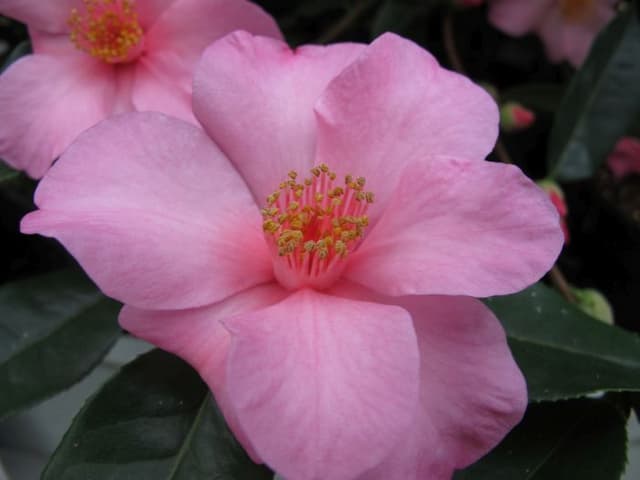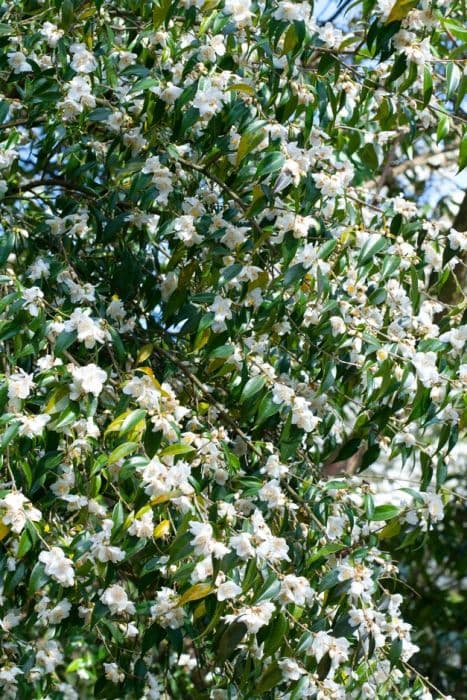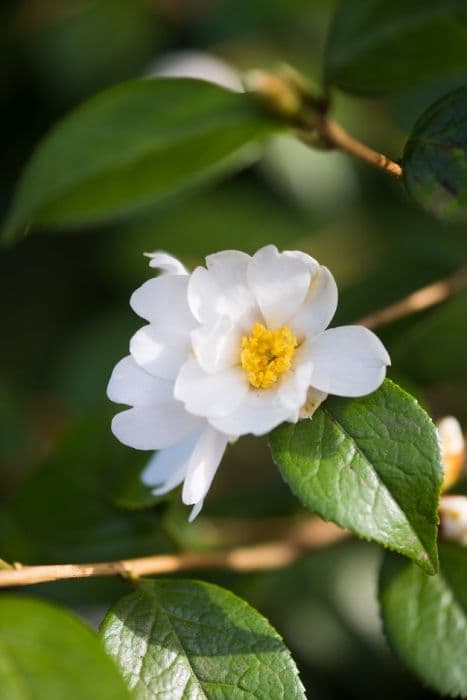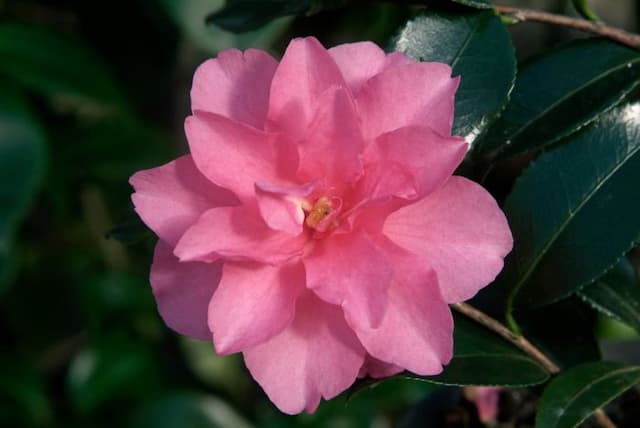Camellia Camellia 'Francie L'

ABOUT
Camellia 'Francie L' is a plant with a visually striking appearance. It is notable for its glossy, deep green leaves that provide a lush backdrop throughout the year. The leaves have a leathery texture, are oval in shape with slightly serrated edges, and remain evergreen, offering continuous visual interest. The true showstopper of this plant is its flowers, which bloom with an opulence that captures the eye of many garden enthusiasts. Camellia 'Francie L' produces large, lavish blossoms that could be compared in size and shape to roses. The flowers exhibit a symphony of color, typically ranging from shades of soft pink to deeper rose hues, often with a hint of variegation which gives the petals an exquisite complexity. They are known for their numerous, ruffled layers that create a dense, peony-like effect. Each flower features a prominent central cluster of golden stamens, contrasting beautifully with the plush petals. This combination of vibrant blooms against the rich green foliage creates a luxurious display that is highly valued in ornamental horticulture. The plant's blooming period is another attractive trait. It tends to flower during the colder months when the garden can be somewhat bereft of color, providing an unexpected and welcome burst of beauty when most other plants have ceased their display. Despite the plant's showy features, one must remember not to focus on the dimensions of its growth, since its appearance can vary significantly depending on the growing conditions and how it is cultivated by the gardener.
About this plant
 Names
NamesFamily
Theaceae
Synonyms
Francie L Camellia
Common names
Camellia 'Francie L'.
 Toxicity
ToxicityTo humans
Camellia 'Francie L', commonly known as camellia, is not considered toxic to humans. There are no reports of serious toxicity or poisoning from ingesting camellia plants. Therefore, consuming this plant should pose no significant health risk to humans.
To pets
Camellia 'Francie L', commonly known as camellia, is generally considered non-toxic to pets. No significant toxicity has been reported for dogs and cats that ingest parts of the camellia plant. However, individual animals might have sensitivity or allergic reactions, so it's always best to discourage pets from chewing on any houseplants or garden plants as a precaution.
 Characteristics
CharacteristicsLife cycle
Perennials
Foliage type
Evergreen
Color of leaves
Green
Flower color
Pink
Height
6-8 feet (1.8-2.4 meters)
Spread
5-7 feet (1.5-2.1 meters)
Plant type
Shrub
Hardiness zones
7
Native area
Asia
Benefits
 General Benefits
General Benefits- Ornamental Appeal: Camellia 'Francie L', commonly known as Camellia, offers aesthetic beauty with its large, showy flowers that can enhance the visual appeal of gardens.
- Seasonal Interest: It blooms in the late winter or early spring, providing color and interest during a time when few other plants are in flower.
- Longevity: Camellias are known for being long-lived plants, which can provide enjoyment for many years with proper care.
- Versatility: This camellia can be used in various landscape applications, including specimen planting, hedging, or as a foundational shrub.
- Ease of Maintenance: Camellias generally require minimal pruning and care once established, which can suit gardeners seeking low-maintenance plants.
- Drought Tolerance: Once established, Camellia 'Francie L' can tolerate periods of dryness, although it prefers consistently moist soil.
- Wildlife Attraction: Camellias can attract pollinators like bees when in bloom, offering a food source for these beneficial insects.
 Medical Properties
Medical PropertiesThis plant is not used for medical purposes.
 Air-purifying Qualities
Air-purifying QualitiesThis plant is not specifically known for air purifying qualities.
 Other Uses
Other Uses- Art and Crafts Supply: The petals of the Camellia can be used to make natural dyes for fabrics or inks for stamping and painting, offering a range of pink to red hues depending on the concentration.
- Culinary Garnishes: The vibrant flowers can be used as edible embellishments on cakes and desserts to add a touch of elegance.
- Photography Prop: Camellia flowers are often used in photography, particularly in portrait and still life arrangements, due to their beauty and variety of colors.
- Perfumery: Some species of Camellia are used in the production of perfumes for their subtle fragrance, adding a floral note to the blend.
- Ceremonial Decor: In certain cultures, Camellias are used in wedding ceremonies and other special events as traditional decorations.
- Eco-friendly Confetti: Dried Camellia petals can serve as a biodegradable alternative to traditional paper confetti at celebrations.
- Bookmarks: Pressed Camellia flowers can be laminated to create beautiful and unique bookmarks.
- Fragrant Sachets: Dried Camellia petals can be placed in small pouches to create natural sachets that impart a mild fragrance to linens and clothing.
- Sustainable Wrapping: Large Camellia leaves can be used to wrap small gifts, providing an eco-friendly and decorative presentation.
- Plant Propagation: Hobby gardeners can propagate Camellias by collecting seeds or cuttings, making it an educational experience in botany and horticulture.
Interesting Facts
 Feng Shui
Feng ShuiThe Camellia is not used in Feng Shui practice.
 Zodiac Sign Compitability
Zodiac Sign CompitabilityThe Camellia is not used in astrology practice.
 Plant Symbolism
Plant Symbolism- Admiration: Camellias generally symbolize admiration, and the 'Francie L' variety is no exception. Its lush blooms represent the adoration one person can have for another.
- Perfection: The camellia flower is often associated with perfection due to its perfect petals and symmetrical form, signifying the idealization of a person or concept.
- Long-lasting Devotion: The sturdy evergreen nature of the camellia plant reflects long-lasting devotion and commitment in relationships, hinting at enduring bonds and affections.
- Deep Desire: With its richly colored blossoms, the Camellia 'Francie L' can symbolize a deep desire or longing for someone, particularly in the context of love and passion.
- Refinement: The elegant appearance of camellias is often associated with refinement and sophistication, suggesting a sense of cultured beauty and polished demeanor.
 Water
WaterThe Camellia 'Francie L', commonly known as the Francie L Camellia, should be watered deeply to encourage strong root development. In general, water when the top inch of soil feels dry to the touch, which may be once a week, but this can vary depending on climate and soil conditions. Always avoid overhead watering to prevent foliar diseases; instead, water at the base of the plant using a soaker hose or drip irrigation. Provide about 1 to 1.5 gallons of water per session for a medium-sized shrub, ensuring it reaches the root zone. During the growing season, maintain a consistent watering schedule, and reduce frequency in winter when the plant is dormant.
 Light
LightThe Francie L Camellia thrives best in partial shade with filtered sunlight. It should be placed in a location where it is protected from intense afternoon sun to prevent scorching of the leaves. The ideal spot is one that receives morning light and dappled shade in the afternoon, such as the eastern side of a building or beneath the canopy of tall trees.
 Temperature
TemperatureThe optimum temperature range for the Francie L Camellia is between 68°F and 85°F. It can tolerate minimum temperatures down to around 10°F once established, but ideally should not be exposed to temperatures below 20°F. During extreme cold, provide protection with mulch or covering during overnight lows, to help ensure the plant’s survival.
 Pruning
PruningPrune the Francie L Camellia to maintain shape and health, primarily by removing any dead or diseased wood and to promote air circulation. The best time for pruning is after the blooming period in spring, as camellias set their next year's flower buds soon after the flowers fade. Light pruning can be done as needed throughout the year; however, extensive pruning should be limited to the post-bloom window.
 Cleaning
CleaningAs needed
 Soil
SoilCamellias require acidic soil with a pH between 5.0 to 6.5; create a mix using 1/3 peat moss, 1/3 pine bark, and 1/3 coarse sand or perlite for good drainage and moisture retention for your Camellia 'Francie L'.
 Repotting
RepottingCamellias like 'Francie L' should be repotted every 2-3 years, preferably in the spring before the onset of the new growth spurt, using fresh acidic soil mix to accommodate their slowly growing root system.
 Humidity & Misting
Humidity & MistingCamellias prefer moderate to high humidity levels; maintaining a humidity level around 40-50% is ideal for 'Francie L' to thrive.
 Suitable locations
Suitable locationsIndoor
Place 'Francie L' in bright, indirect light and maintain high humidity.
Outdoor
Plant 'Francie L' in partial shade with shelter from strong wind.
Hardiness zone
7-9 USDA
 Life cycle
Life cycleThe Camellia 'Francie L', or commonly known as Camellia, begins its life cycle when a seed germinates, typically in a moist, well-drained growing medium. The seedling emerges and develops into a young plant with a rosette of leaves at the soil surface. As the camellia matures, it develops a woody stem and a more expansive root system. In its adult stage, the camellia produces buds that bloom into large, ornamental flowers, usually during fall or winter depending on the climate. After pollination, the flowers produce seed capsules which eventually release seeds, allowing the life cycle to begin anew. Throughout its life, the camellia requires pruning to maintain shape and encourage flowering.
 Propogation
PropogationPropogation time
Spring-Early Summer
Camellia 'Francie L', commonly known as a variety of Camellia, is most commonly propagated through semi-hardwood cuttings. This method usually takes place during late summer or early fall when the plant's growth begins to slow down. To propagate by cuttings, a gardener would select healthy, semi-hardwood branches from the current season's growth and cut segments approximately 4 to 6 inches (10 to 15 centimeters) in length, making sure each cutting has at least two to three leaves. The cut end is often dipped in rooting hormone powder to encourage root development and then inserted into a well-draining potting mix. The cuttings are then kept in a humid environment with indirect light until roots have developed, which can take several weeks to a few months. Maintaining consistent moisture and temperature is key during this period to ensure successful rooting and growth of the new Camellia 'Francie L' plants.









